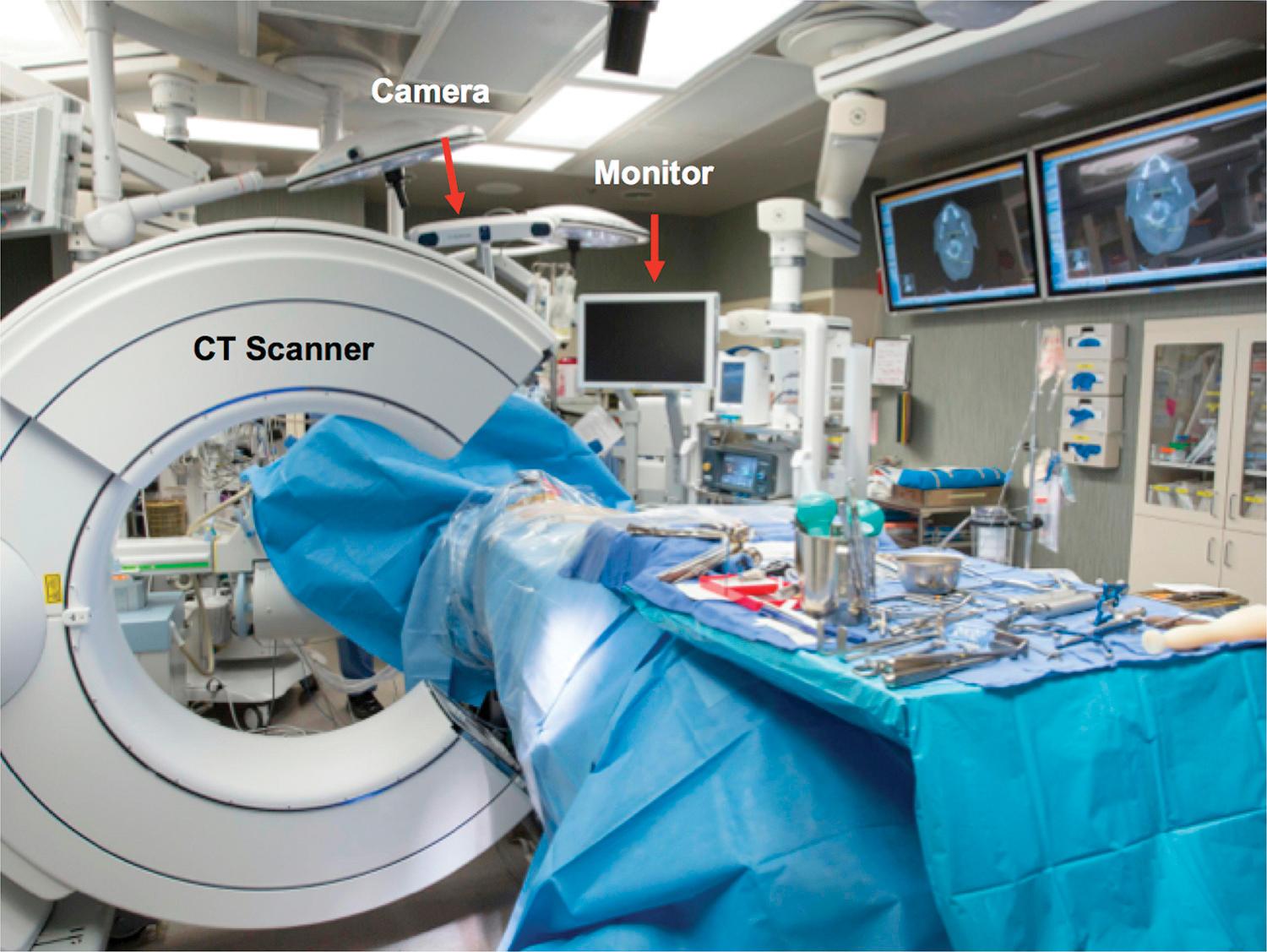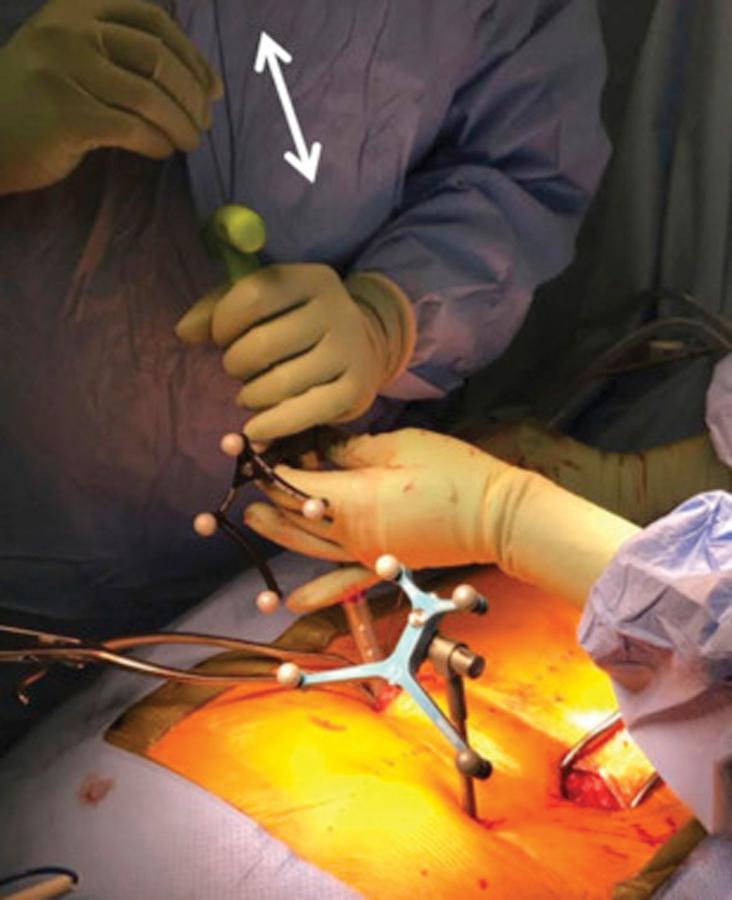Physical Address
304 North Cardinal St.
Dorchester Center, MA 02124
Spinal navigation was introduced in the early 1990s as advances in computer-based technologies enabled a transition from frame-based systems developed for cranial surgery to frameless navigation systems. First-generation frameless systems involved a range of technologies, including two-dimensional (2D) fluoroscopy and wired navigation instruments. Second-generation systems involved passive reflective reference frames, point-by-point matching (PPM), self-registration, and relied on preoperative computed tomography (CT) datasets loaded onto an image postprocessing workstation. Current generation systems encompass and incorporate intraoperative three-dimensional (3D) CT (and CT-like) imaging with automatic registration and computer-guided software that allow the user to visualize 3D spinal anatomy and track instrumentation in real time.
Intraoperative spinal navigation is based on the principles of stereotaxy , which refers to localization of a specific point in space using a 3D coordinate system. Spinal imaging data and anatomic data from the surgical field are defined within separate 3D Cartesian coordinate systems and specific points within each dataset are matched using mathematical algorithms. Establishment of a spatial relationship between spinal imaging data and anatomic data from the surgical field is created through a process referred to as registration . Various registration methods have been described, including paired-point registration, surface-matching registration, and automatic registration. The aim of intraoperative spinal navigation is to track surgical instruments and spinal anatomy in the operative field in relation to a registered reference point. This is commonly performed using marker spheres attached to surgical instruments and a reference frame that is fixed to bony landmarks outside the immediate operative field. A camera is used to track the position of surgical instruments and spinal implants with respect to the reference frame and the resulting data is transmitted to the workstation where the data is processed for display.
An Intraoperative Spinal Navigation System consists of four major components:
Imaging modality: Navigation may be based on use of an intraoperative imaging modality such as a 3D CT or CT-like scanner or 3D fluoroscopy scanner. Alternatively, imaging data obtained intraoperatively can be matched with preoperative CT data and used to guide surgery.
Reference frame: Provides a fixed point of reference to which navigated instruments are measured and displayed. Common sites for attachment of a reference frame (also referred to as a dynamic reference array) include the posterior spinal elements or ilium.
Reflective light camera scanner: Detects both the reference frame and the navigated instruments in a 3D grid, and sends the positional coordinates to the computer workstation.
Marker spheres: Reflective spheres are attached to the navigated instruments and are tracked by the reflective camera on the navigation station.
Computer workstation with appropriate software that integrates the intraoperative image and positional coordinates from the scanner to provide a real-time graphical representation of the navigated instruments in the spine ( Figs. 69.1 and 69.2 ).


Spinous process clamp
Head holder attachments (Mayfield skull clamps)
Posterior superior iliac spine percutaneous pins
Surgical mask–based system (skin-adhesive cutaneous frame)
Pedicle screw clamps (for revision cases with screws in place or for second intraoperative navigation scans)
Yes. Spinal navigation has been shown in multiple meta-analyses, prospective randomized studies, and cadaveric studies to be more accurate for the insertion of pedicle screws and is associated with lower revision surgery rates compared with 2D fluoroscopy or freehand methods. On average, the reported radiographic accuracy rates are as follows: CT navigation, 97% (range: 86%–100%); 2D fluoroscopy, 90% (range: 80%–93%); freehand, 85% (range: 69%–94%). On average, the reported revision surgery rates are: CT navigation, <1%; 2D fluoroscopy, <2%; and freehand, <10%.
Accuracy rates of pedicle screw placement are commonly reported based on whether pedicle screws are located entirely within the pedicle. The amount of pedicle breach is commonly measured in millimeters and graded from A to E according to the Gertzbein-Robbins classification: Grade A (0 mm breach), B (<2 mm), C (<4 mm), D (<6 mm), E (≥6 mm). The clinical significance of a pedicle breach depends on several factors, including breach direction, breach magnitude, spinal level, presence of a positive electromyography (EMG) response or neurologic deficit or other clinical sequalae. Medial breach is a concern due to the proximity of neural structures, while anterior breach of the vertebral body cortex endangers vascular and visceral structures. However, lateral breach in the thoracic spinal region may be contained within the posterior rib, and thoracic screw trajectories that involve intentional lateral pedicle penetration (the “in-out-in” technique) have been recommended to optimize thoracic fixation. It has been reported that less than 5% of misplaced pedicle screws are associated with symptoms. Medial pedicle breach >2 mm is considered significant in various literature reports. However, it is challenging to compare breach rates between studies due to variable verification methods and different definitions of breaches.
Spinal navigation was initially used to guide placement of pedicle screws in the thoracic and lumbar regions. Subsequently, use of spinal navigation has expanded to all types of spinal surgery including cervical instrumentation, iliac and S2 alar-iliac screw placement, transoral procedures, spinal deformity surgery, revision surgery, corpectomy, interbody fusion, tumor resection, video-assisted thoracoscopic surgery, surgery involving congenital osseous anomalies, and minimally invasive surgery.
CT navigation in spinal surgery is a high-demand technologic advancement for the delivery of instrumentation. It relies heavily on input from multiple disciplines (radiology, anesthesia and nursing staff, surgical technologists, navigation technologists) to successfully implement image guidance in the operative room. Organization and management of this multidisciplinary team is more complex compared to use of fluoroscopy. Coordination of the movement of each individual during navigation, and emphasis of the importance of execution of each team member’s role, is critical to maintaining a smooth workflow that is free of disruptions.
Patient setup
Exposure
Reference frame placement
Intraoperative image acquisition (CT spin)
Calibration of instruments
Navigated screw placement (point-drill-tap-screw)
Decompression, cage placement (if necessary)
Rod measurement and placement
Additional CT spins may be required when anatomy is altered, for multilevel implant constructs, or to confirm implant placement
Become a Clinical Tree membership for Full access and enjoy Unlimited articles
If you are a member. Log in here